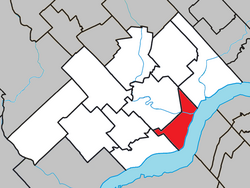Batiscan, Quebec
| Batiscan | |
|---|---|
| Municipality | |

Saint-François-Xavier Church
|
|
| Motto: Fais bien ce que tu fais ("Do Well What You Do") |
|
 Location within Les Chenaux RCM. |
|
| Location in central Quebec. | |
| Coordinates: 46°30′N 72°15′W / 46.500°N 72.250°WCoordinates: 46°30′N 72°15′W / 46.500°N 72.250°W | |
| Country |
|
| Province |
|
| Region | Mauricie |
| RCM | Les Chenaux |
| Settled | 1666 |
| Constituted | July 1, 1855 |
| Government | |
| • Mayor | Sonya Auclair |
| • Federal riding | Saint-Maurice—Champlain |
| • Prov. riding | Champlain |
| Area | |
| • Total | 58.90 km2 (22.74 sq mi) |
| • Land | 42.95 km2 (16.58 sq mi) |
| Population (2011) | |
| • Total | 940 |
| • Density | 21.9/km2 (57/sq mi) |
| • Pop 2006-2011 |
|
| • Dwellings | 510 |
| Time zone | EST (UTC−5) |
| • Summer (DST) | EDT (UTC−4) |
| Postal code(s) | G0X 1A0 |
| Area code(s) | 418 and 581 |
| Highways |
|
| GNBC Code | ELIDL |
| NTS Map | 031I08 |
| Website | www |
Batiscan is a municipality in the Mauricie region of the province of Quebec in Canada. It is located along the Saint Lawrence River at the mouth of the Batiscan River.
In 1609, Samuel de Champlain, on his way to Lake Champlain, wrote of a Huron and Algonquin encampment one and a half leagues from St. Mary's River, which places it around the modern settlement of Batiscan. A year later, he wrote of having met an indigenous leader called "Batiscan". On his map of 1612, Champlain designated this area north of the Saint Lawrence River as the "region of bastisquan". While the name has virtually remained unchanged since first mentioned by Champlain, its meaning has remained uncertain, possibly meaning mist or haze (as often seen at the mouth of the Batiscan River), pulverized dried meat, rushes, or even making a mistake, taking a misstep.
In 1636, the Madeleine Seignory was granted to Jacques Laferté, and included all the territory between the Chevrotière and Saint-Maurice Rivers, until 100 kilometers inland from the Saint Lawrence River. Subsequently, the seignory was divided into several smaller estates or fiefs, including the Batiscan Fiefdom that on March 13, 1639, was given to the Jesuits to accommodate the evangelization and the settlement of Indian tribes living there. This territory corresponded approximately to the current municipalities of Batiscan and Saint-Geneviève-de-Batiscan.
The actual colonization of the area began in 1666, and it developed according to the seigneurial system of New France. The land granted to each settler was typically a long narrow rectangle with a proportion of about 1 to 10, that would allow each settler access to the river and the road. By 1709, all land bordering the Saint Lawrence River was occupied and a second row was equally divided inland. Over time, the territory of Batiscan grew to have 3 rows south-west of the Batiscan River and 2 rows north-east of it.
...
Wikipedia

